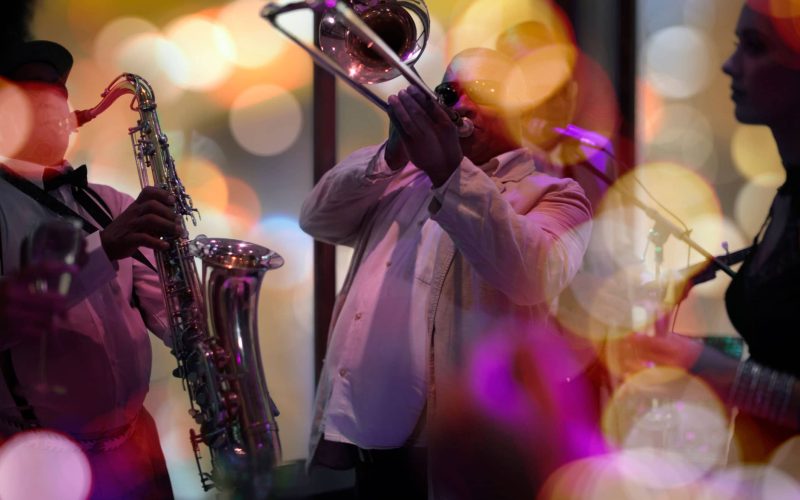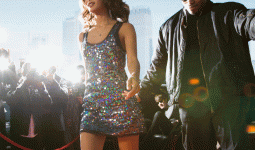The different types of jazz are musical genres that began in the United States around the turn of the twentieth century.
Its origins are blues music, which has spawned a variety of jazz forms throughout the last century.
Let’s take a look at 15 different types of jazz.
1. Early Jazz
The first forms of jazz emerged in the late 1800s and early 1900s. “Ragtime” or “playing hot” was the name of the style that gained popularity in New Orleans.
Furthermore, most bands consisted of the violin (later replaced by guitar), cornet, clarinet, trombone, drums, double bass (later replaced by a banjo and a tuba), and one or two wind instruments.
. Additionally, audiences flocked to syncopated notes and rhythms in droves.
2. Swing
Swing music is one of the different types of jazz that became popular in the 1930s and 1940s.
Furthermore, “Big bands” with a variety of players in sections such as rhythm (piano, percussion, guitar, bass), brass (trumpets and trombones), woodwind (clarinet and saxophones), and vocals were usually used to perform swing music.
Additionally, swing music was characterized by odd beats. Because of the band’s size, several charts had a loud, energetic sound.
3. Bebop
Bebop was influenced by swing, although its sound was apart from it. It was fun to play and listen to since it was loud, rapid, and exhilarating.
When the genre was born in the early 1940s, Dizzy Gillespie, Thelonious Monk, and Charlie Parker were regarded as youthful Turks.
This paved the path for musicians such as Miles Davis and Art Blakely. Besides, bebop was a specialized genre intended to gratify a jazz artist.
Furthermore, fast tempos, complicated compositions, and tremendous instrumentalizations contributed to the public’s lack of approval.
Especially when the public much more easily digested the swing.
4. Dixieland
Dixieland, often known as New Orleans jazz or marching jazz. It is characterized by lively brass, energetic rhythms, and catchy compositions like When the Saints Go Marching In.
In Dixieland music, a single instrument plays the song’s melody while the rest of the band improvises around it.
As a result, the music is vibrant and enjoyable, with a distinct sound.
Dixieland is one of the different types of jazz that originated in New Orleans in the early 1900s. And it is still popular throughout the South today.
5. Hard Bop
Hard Bop emerged in the 1950s and 1960s. It is a sophisticated and varied musical genre characterized by dark, soulful pitches, blues-like lyrics, gospel-like chord progressions, and focused drumming.
6. Cool Jazz
The 1940s and 1950s were when there were few genres to choose from. People had a limited selection of music to listen to, including Bebop.
However, cool jazz provided a counterpoint to Bebop’s frenetic approach. It had a laid-back feel, lovely harmonies, and sluggish tempos.
Meanwhile, the music reflected California’s laid-back demeanor where the sound started.
Cool jazz incorporated formal arrangements and drew inspiration from classical music. Cool jazz is also one of the different types of jazz.
7. Latin Jazz
Afro-Cuban and Afro-Brazilian jazz were two Latin-style styles that grew prominent in the 1960s and 1970s.
Furthermore, these styles included Latin rhythms on instruments like the timbales or claves, as well as bossa nova or samba bass lines.
However, these beats have a lot of syncopation and are influenced by Latin and African rhythms.
Unlike other jazz styles, Latin jazz uses straight eighth notes, in which musicians simultaneously play each note of an eighth pair.
8. Fusion
Fusion is a musical genre that combines jazz, rock, soul, and funk. It was the most popular style from 1968 to 1984 and possessed energy unlike any other.
Additionally, fusion was a creative and financially successful jazz form.
However, because it merged with other styles, it did not sit well with many jazz purists.
9. Funk
Jazz Funk is one of the different types of jazz from the early 1970s. Electronic elements and a strong, grooving beat characterize jazz-funk. In the 1970s and 1980s, music became increasingly popular.
Additionally, funk music is very danceable due to its rhythm and pace, making it a popular dance club staple.
Furthermore, instruments such as synthesizers and electric pianos are not generally found in jazz music.
The electric bass was usually used with more traditional jazz instruments, such as drums, pianos, brass instruments, and saxophones.
10. Modal Jazz
Modal jazz, which Miles Davis and John Coltrane pioneered, included extensive mode modulation and few chord changes.
However, it stretched the boundaries of jazz, especially bebop.
Modal jazz centered on one tonal center to create a more melodic song instead of fast chord progressions and complex instrumentation.
11. Acid Jazz
Acid jazz, one of the different types of Jazz, arose from the London club scene in the mid-1980s.
Its musicians usually sampled conventional jazz compositions and combined them with a grooving electronic beat.
Other musicians fused jazz, hip-hop, and funk components to produce dance music with a distinct electric feel.
Furthermore, acid jazz is usually composed of a rhythm section, horns, and vocalists, rappers, or DJs.
In addition, J. Spencer’s Blue Moon, Balanco’s Cinnamon & Clove, and Liquid Soul’s Show Me are all popular acid jazz tunes.
12. Free Jazz
The origins of free jazz can be traced back to the early 1960s in New York, a time when jazz was in desperate need of a breath of fresh air.
Free jazz, as the name implies, broke all of jazz’s previous restrictions. Any rules did not constrain musicians; they could do whatever they wanted.
Furthermore, the genre had no standard structures, tempos, tones, or chord changes.
Many songs used world and ethnic music, and there was a lot of modulation and improvisation.
As a result, Free jazz has received a lot of unfavorable press. Ornette Coleman, John Coltrane, Pharoah Sanders, and Tony Williams were all part of the Free Jazz movement.
13. Smooth Jazz
Smooth jazz is one of the different types of jazz that became popular in the 1980s and beyond. It is sometimes known as adult contemporary music.
Softer tempos and melodic instrumental or vocal solos characterize it.
Furthermore, most smooth jazz compositions are slow enough to be classified as ballads.
Saxophones and vocals are two of the most prominent solo instruments in smooth jazz, which was so popular in the 1990s and early 2000s that many radio stations broadcast a smooth jazz station exclusively.
14. Avant-Garde Jazz
Avant-garde is another genre that aims to expand the boundaries of jazz.
Its radical harmonies, improvisation, and atonality made it popular in the 1950s.
Additionally, the former’s apparent inspiration from Western classical music set this jazz form apart from its contemporary free jazz counterparts.
Furthermore, John Coltrane, Ornette Coleman, Sun Ra, and Pharoah Sanders are attributed to the emergence of avant-garde jazz.
15. Gypsy Jazz
Django Reinhardt and Stephane Grapelli, the Hot Club Quintet members, made Gypsy Jazz popular in Paris in the 1930s.
However, its name comes from the fact that Romani people mostly performed it at the time.
Guitars, violins, and a stand-up bass were the most common instruments used in Gypsy Jazz.
Guitarists adopted the La Pompe technique, which removed the need for drums.
It’s only a matter of plucking the backbeats hard enough to make a thud.
Furthermore, the genre has a swing feel. The melodies are often singable, and the music is smooth simple, but complex.
In conclusion, jazz has grown, incorporating classical and African music influences and spanning various genres.
With so many jazz genres to choose from, choosing a type you like is simple. Listen to some jazz to expand your musical horizons.








